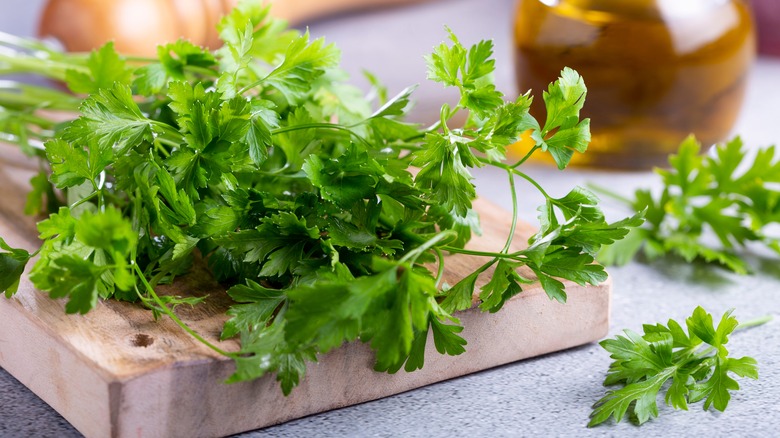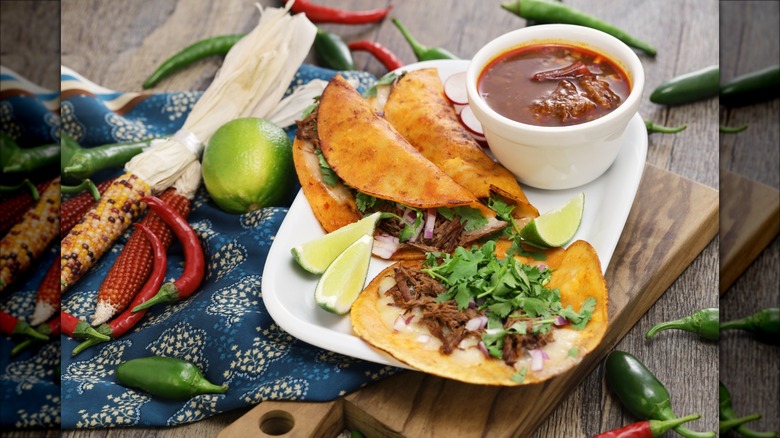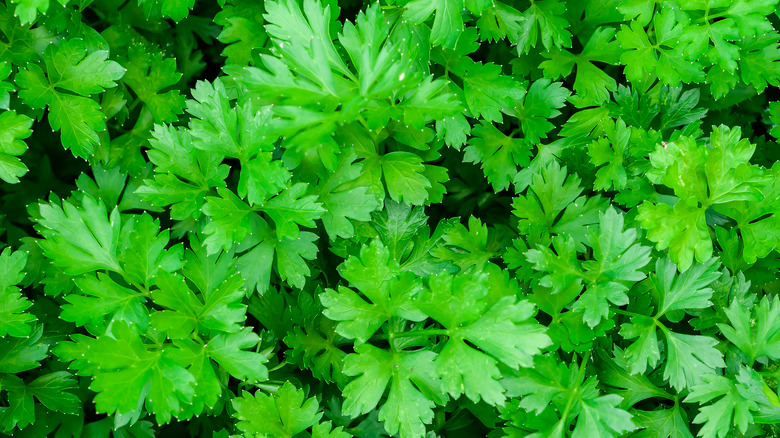What's The Difference Between Cilantro And Parsley?
We've all been there: You're at the supermarket shopping for a recipe, but you find yourself stumped once you get around to the herb section, where everything looks almost the same. Which one is cilantro? Which is coriander? Or is it parsley? Darn it, they look so similar — it's tempting to assume they might be interchangeable! Unfortunately, they're not, and using the correct herb in your cooking is crucial to the flavor profile of your recipe (via Masterclass). You wouldn't put basil in a mint julep, or mint in a caprese salad, right?
Not all herbs are so easily distinguishable, though. The two that probably get confused the most are cilantro and parsley. (If you're from outside North America, you're probably wondering what the heck "cilantro" even is — to clarify, internationally cilantro leaves, stems, and seeds are all called by the plant's other name, coriander, as Healthline notes.)
According to Masterclass, most recipes that call for cilantro refer to using the fresh leaves and stems of the plant. You'll find cilantro in the fresh herb section of most supermarkets. If the recipe asks for coriander or coriander seeds, then you'll need to head over to the spices section of the supermarket and buy a jar of dried seeds from the plant. As Healthline explains, the flavor profiles of fresh cilantro and dried coriander seeds are very different, so you can't mix and match them in a recipe. Now that you know a little background on cilantro, let's dive into this fragrant question and get it settled once and for all!
Love it or hate it: cilantro has an interesting history
Cilantro is one of those ingredients that people seem to either love or hate, kind of like IPA brews or blue cheese. On a global level, however, many cuisines simply can't live without this brightly flavored herb. According to NPR, references to humans enjoying cilantro date back all the way to ancient Egypt, and today, the herb continues to be a culinary staple.
Not liking blue cheese is probably just a personal preference. But if you have an adverse reaction to the flavor of an IPA (as HuffPost notes), or start tearing up from the "soapy" smell or taste of fresh cilantro, then the cause might be something different. Thanks to your genetic history, your nose might find cilantro particularly disagreeable (via Flavour). The good news is if you're one of those people, identification should be a cinch — just follow (or don't follow) your upset nose!
For the rest of us, there are still a few tricks to employ. First up is simply smelling the herb. Pinch a tiny fragment of the herb off and let your nose do the work: does it smell citrusy? That's cilantro! You can also choose by the shape of its leaves: If they're curved instead of pointy, you've got the right plant, according to Healthline. And last but not least, you can just buy a cilantro plant, keep it on your windowsill, and never be confused again — plus, it feels pretty boss to casually reach over and snip off fresh herbs for a recipe.
You can probably thank ancient Greece for parsley's popularity
Oh, parsley. For such a mildly-flavored herb it has a famously rich history, even gracing the likes of ancient Greek tombs as a symbol of death, per the University of Wisconsin Madison's horticulture department. As the European Ministry of Foreign Affairs additionally notes, dried parsley is a bestseller in many European countries — making it one of the most popular herbs on the continent. These days, parsley can be found in dishes spanning the world, from Middle Eastern tabbouleh to Argentinian beef burgers with chimichurri.
Here are a few tips to make sure you identify the right herb. As The Old Farmer's Almanac explains, you can grow parsley indoors or outdoors for the easiest identification ever (not to mention a more sustainable option that will reduce plastic packaging). Much like cilantro, parsley can be identified by leaf shape — but in this case, the leaves are pointed and not curved, per Healthline.
But before you nab a parsley bouquet, remember that there are two types of parsley: A variety with very tightly curled leaves, and a variety with flat, broad leaves (via the University of Florida). Ultimately, your best bet to differentiate between parsley and cilantro is to try the smell test, grow your own, or ask a supermarket employee!


